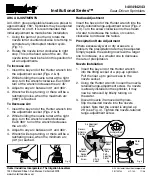
12
Arsenic Facts
Arsenic (As) is a naturally occurring contaminant found in many
ground waters . Arsenic in water has no color, taste or odor . It must
be measured by an arsenic test kit or lab test .
Public water utilities must have their water tested for arsenic . You
can obtain the results from your water utility contained with in your
consumer confidence report . If you have your own well, you will need
to have the water evaluated . The local health department or the state
environmental health agency can provide a list of test kits or certified
labs .
There are two forms of arsenic: pentavalent arsenic (also called As
(V), As (+5)) and trivalent arsenic (also called As (III), As (+3)) . In well
water, arsenic may be pentavalent, trivalent, or a combination of
both . Although both forms of arsenic are potentially hazardous to
your health, trivalent arsenic is considered more harmful than pen-
tavalent arsenic .
RO systems are very effective at removing pentavalent arsenic . A free
chlorine residual will rapidly convert trivalent arsenic to pentavalent
arsenic . Other water treatment chemicals such as ozone and potas-
sium permanganate will also change trivalent arsenic to pentavalent
arsenic . A combined chlorine residual (also called chloramine) where
it does convert trivalent arsenic to pentavalent arsenic, may not con-
vert all the trivalent arsenic in to pentavalent arsenic . If you get your
water from a public water utility, contact the utility to find out if free
chlorine or combined chlorine is used in the water system .
This Watts reverse osmosis system is designed to remove up to
98% of pentavalent arsenic . It will not convert trivalent arsenic to
pentavalent arsenic . Under laboratory standard testing conditions,
this system reduced 0 .30 mg/L (ppm) pentavalent arsenic to under
0 .010 mg/L (ppm) . (The USEPA standard for drinking water) . Actual
performance of the system may vary depending on specific water
quality conditions at the consumer’s installation . In addition to the
independent laboratory standard testing conditions, Watts has
conducted additional field testing on our reverse osmosis units to
determine trivalent arsenic reduction capabilities . Based upon Watts
field testing, it has been determined that the RO units are capable of
reducing up to 67% of trivalent arsenic from the drinking water .
The RO membrane component of this Watts reverse osmosis system
must be maintained according to its recommended maintenance
cycle . Specific component identification and ordering information can
be found in the installation/operation manual maintenance section,
by phone at 1-800-224-1299 or online www .watts .com


































